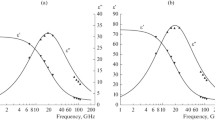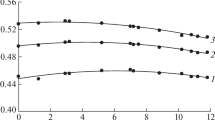Abstract
A new approach to the analysis of aqueous solutions has been developed, which makes it possible to study simultaneously their dielectric, quasi-optical, and radio-brightness parameters in the centimeter and millimeter spectral regions. An interesting property is found in the range of low second-component concentrations: the intrinsic emission in the millimeter range from some solutions is either stronger or weaker than that from pure water. Radio-brightness changes are associated with the presence of two comparable contributions determined by the ratio of ionic and dipole dielectric losses. This effect is considered as applied to simple aqueous systems and more complex biological objects.
Similar content being viewed by others
REFERENCES
O. V. Betskii, V. V. Kislov, and N. N. Lebedeva, Millimeter Waves and Living Systems (Sains-Press, Moscow, 2004) [in Russian].
A. Kh. Tambiev, N. N. Kirkorov, and O. V. Betskii, Millimeter Waves and Photosynthetic Organisms, Ed. by Yu. V. Gulyaev and A. Kh. Tambiev (Radiotekhnika, Moscow, 2003) [in Russian].
A. K. Lyashchenko, “Structure of water, millimeter waves and it’s first order target in biological objects,” Biomed. Radioelectron., No. 8-9, 62–76 (2007) [in Russian]. https://www.elibrary.ru/item.asp?id=10338222
A. M. Shutko, Microwave Radiometry of the Water Surface and Soils (Nauka, Moscow, 1986) [in Russian].
I. N. Sadovskii, E. A. Sharkov, A. V. Kuz’min, D. S. Sazonov, and E. V. Pashinov, “Review of models of the complex permittivity of the aqueous medium used in remote sensing practice,” Issled. Zemli Kosmosa, No. 6, 79–86 (2014) [in Russian]. https://doi.org/10.7868/S0205961414060050
A. K. Lyashchenko and V. S. Dunyashev, “Dielectric and radio-brightness changes in aqueous solutions of electrolytes and biological effects at millimeter waves,” Phys. Wave Phenom. 29 (2), 169–173 (2021). https://doi.org/10.3103/S1541308X21020096
A. K. Lyashchenko, I. M. Karataeva, and V. S. Dunyashev, “Relationship between radioluminance and the dielectric properties of aqueous salt solutions in the millimeter-wavelength spectral range,” Russ. J. Phys. Chem. A 93 (4), 682–687 (2019). https://doi.org/10.1134/S0036024419040204
A. K. Lyashchenko, A. Yu. Efimov, V. S. Dunyashev, and I. M. Karataeva, “Radiation of aqueous solutions of salts with multiply charged cations and their dielectric properties in the millimeter band,” Russ. J. Inorg. Chem. 65 (2), 241–246 (2020). https://doi.org/10.1134/S0036023620020096
A. S. Lileev, D. V. Loginova, and A. K. Lyashchenko, “Dielectric properties of aqueous hydrochloric acid solutions,” Mendeleev Commun. 17 (6), 364–365 (2007). https://doi.org/10.1016/j.mencom.2007.11.024
A. K. Lyashchenko and A. S. Lileev, “Dielectric relaxation of water in hydration shells of ions,” J. Chem. Eng. Data 55 (5), 2008–2016 (2010). https://doi.org/10.1021/je900961m
A. K. Lyashchenko and A. Yu. Zasetsky, “Complex dielectric permittivity and relaxation parameters of concentrated aqueous electrolyte solutions in millimeter and centimeter wavelength ranges,” J. Mol. Liq. 77 (1–3), 61–75 (1998). https://doi.org/10.1016/S0167-7322(98)00068-3
A. K. Lyashchenko, I. M. Karataeva, A. S. Kozmin, and O. V. Betskii, “Radio brightness contrasts and radiation of aqueous salt solutions in the millimeter spectral range,” Dokl. Phys. Chem. 462 (2), 127–130 (2015). https://doi.org/10.1134/S0012501615060032
V. I. Krivoruchko, “Five-millimeter radiometric receiver with a low-noise input amplifier,” Radiophys. Quantum Electron. 46 (8), 703–706 (2003). https://doi.org/10.1023/B:RAQE.0000025000.54205.de
A. S. Koz’min, Candidate’s Dissertation in Mathematics and Physics (Volgograd State Tech. Univ., Volgograd, 2011).
K. S. Ivanova, A. K. Lyashchenko, and A. S. Lileev, “Maximum electrical conductivity and hydrate numbers in solutions of alkali metal carboxylates,” Zh. Neorg. Khim. 36 (10), 2724–2730 (1991) [in Russian].
K. S. Cole and R. H. Cole “Dispersion and absorption in dielectrics II. Direct current characteristics,” J. Chem. Phys. 10, 98–105 (1942). https://doi.org/10.1063/1.1723677
J. B. Hasted, Aqueous Dielectrics (Chapman & Hall, London, 1973).
Funding
This work was supported by the Ministry of Science and Higher Education of the Russian Federation as a part of the State Assignment for the Kurnakov Institute of General and Inorganic Chemistry of the Russian Academy of Sciences.
Author information
Authors and Affiliations
Corresponding author
Ethics declarations
The author declares that he has no conflicts of interest.
Additional information
Translated by Yu. Sin’kov
About this article
Cite this article
Lyashchenko, A.K. The Effect of Millimeter Waves in Aqueous Systems and Biological Environments Caused by Their Radio-Brightness Contrasts. Phys. Wave Phen. 30, 182–185 (2022). https://doi.org/10.3103/S1541308X22030062
Received:
Revised:
Accepted:
Published:
Issue Date:
DOI: https://doi.org/10.3103/S1541308X22030062




